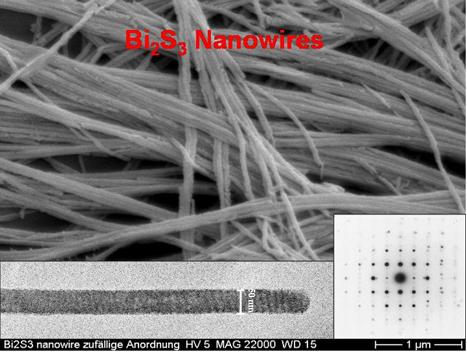|
|
ELECTROCHEMICALLY-DEPOSITED Bi2S3 and Pb3xBi2(1-x)S3
NANOWIRES FROM NONAQUEOUS ELECTROLYTES
J. Sommerlatte1,2, W. Lee1, R. Scholz1, U. Gösele1, C. Bente2
and K. Nielsch1
1) Max Planck Institute of Microstructure Physics, Halle, Germany
2) Institute of Mineralogy, University of Leipzig, Germany
|
|
Thermoelectric nanowires have been predicted to have superior thermoelectric properties over bulk materials.
Sulfosalts in general and especially bismuth sulfide and the Bi2S3-PbS compounds are semiconductors with a direct
band gap transition. The band gap of the bulk Bi2S3-PbS alloys can be adjusted over a wide range from 0.25 eV up
to 1.6 eV and exhibit a large variety of crystal phases. Due to the modular crystal structure Pb3xBi2(1-x)S3 tends
to grow in a needle-like shape. Therefore these compound semiconductors are very suitable for the synthesis of
crystallographically-oriented 1D nanostructures. In this paper we report on the synthesis of Bi2S3 and Pb3xBi2(1-x)S3
nanowires by electropdeposition in highly ordered alumina membranes with a monodisperse pore diameter of 50 nm. We
have chosen Dimethylsulfoxide (DMSO) as a nonaqueous solvent for the electrolyte and e.g. 0.055 M BiCl3 and 0.19 M
sulfur as precursors. The deposition of Bi2S3 and Pb3xBi2(1-x)S3 took place under inert gas atmosphere at elevated
temperatures (110°C). For the Bi2S3 deposition we have obtained nearly single crystalline nanowires and a homogenous
pore filling up to membrane thicknesses of 30 µm. The Bi2S3 nanowires exhibit the bismuthumite phase with a
preferential orientation of the c axis parallel to the nanowire axis. In case of Bi2S3-PbS-compounds we obtained
polycrystalline phase mixtures with an extended amount of lead dissolved in the crystal structure in comparison to
the corresponding crystal phase of the bulk material. By varying the bismuth concentration from x= 0.2 to 0.5 we
have obtained Pb3xBi2(1-x)S3 nanowires which exhibit the cosalite Pb2Bi2S5 or lillianite Pb2Bi3S6 phase as the
dominating crystal structure.
We thank the German Ministry for Education and Research (BMBF, project number 03N8701)
for financial support.

|
|